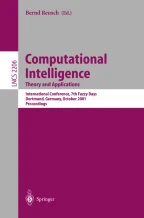Abstract
Data-analysis has undergone an important change from statistical descriptive analysis to data-mining. Information networks and huge data-storage equipments brought data-retrieval to new dimensions. Time-series are especially easy to accumulate as digital sensors can be used to fill databases without any intervention. This is both a boon and a problem as the very amount of data available prevents the user from being able to understand them. One has to build high-level representations of the time-series to be able to extract some information. Segmentation is often used in process-monitoring for similar reasons.
In this paper, we describe step by step difficulties and solutions that we studied when adapting automated time-series segmentation to a real-world example of electric consumption analysis. The data that we want to analyze consist of yearly reports of electric power consumption in 10 minute ticks. We study industrial consumers that have simple processes (ovens, motors) switched either on or off for the duration of the process. Hence we could use this prior knowledge to model the time-series with piecewise constant changing mean models. We then extend the segmentation to a symbolic representation to enable interpretation of the overwhelming number of generated segments.
Access this chapter
Tax calculation will be finalised at checkout
Purchases are for personal use only
Preview
Unable to display preview. Download preview PDF.
Similar content being viewed by others
References
H. Akaike. Information theory and an extension of the maximum likelihood principle. In B. N. Petrov and F. Cáski, editors, Second International Symposium on Information Theory, pages 267–281, Budapest, 1973. Akademiai Kaidó. Reprinted in Breakthroughs in Statistics, eds Kotz, S. & Johnson, N. L. (1992), volume I, pp. 599–624. New York: Springer.
Michael A. Eisenberg. The kineticist’s workbench: Combining symbolic and numerical methods in simulation of chemical reaction mechanisms. Technical report, Massachusetts Institute of Technology, 1991.
Valery Guralnik and Jaideep Srivastava. Event detection from time series data. In Surajit Chaudhuri and David Madigan, editors, Proceedings of the Fifth ACM SIGKDD International Conference on Knowledge Discovery and Data Mining, pages 33–42, N.Y., August 15–18 1999. ACM Press.
G. Schwarz. Estimating the dimension of a model. The Annals of Statistics, 6:461–464, 1978.
R. Srikant and R. Agrawal. Mining sequential patterns: Generalization and performance improvements. In EDBT, March 1996.
L. A. Zadeh. Fuzzy logic = computing with words. IEEE Transactions on Fuzzy Systems, 4(2):103–111, 1996.
Author information
Authors and Affiliations
Editor information
Editors and Affiliations
Rights and permissions
Copyright information
© 2001 Springer-Verlag Berlin Heidelberg
About this paper
Cite this paper
Hugueney, B., Bouchon-Meunier, B. (2001). Time-Series Segmentation and Symbolic Representation, from Process-Monitoring to Data-Mining. In: Reusch, B. (eds) Computational Intelligence. Theory and Applications. Fuzzy Days 2001. Lecture Notes in Computer Science, vol 2206. Springer, Berlin, Heidelberg. https://doi.org/10.1007/3-540-45493-4_16
Download citation
DOI: https://doi.org/10.1007/3-540-45493-4_16
Published:
Publisher Name: Springer, Berlin, Heidelberg
Print ISBN: 978-3-540-42732-2
Online ISBN: 978-3-540-45493-9
eBook Packages: Springer Book Archive
